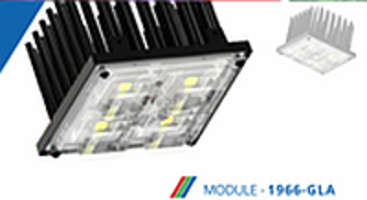Adura Launches LED Light Engines Optimized for Horticultural Lighting Fixtures

Cree LEDs, including some of the Photo Red horticultural LEDs, are combined with LEDiL optics and Adura SinkPad technology in the 1966-GLA and 1950-GLA horticultural LED light engines.
Light-engine manufacturer Adura has announced two new modular LED light engines that specifically target horticultural solid-state lighting (SSL) applications. The finished modules include LEDs, optics, and thermal elements that enable integration in passively-cooled luminaires. The modules mix phosphor-converted white LED and red LEDs to deliver high levels of photosynthetic photon flux (PPF).
Interested in articles & announcements on horticultural lighting technology?
For background on PPF and other metrics and requirements specific to horticultural lighting, see our feature article on the topic. Basically, lighting for horticultural applications needs energy peaks in the red and blue regions along with significant energy across the spectral power distribution (SPD).
Back last summer and again in the fall, Cree introduced what it called Photo Red LEDs across a number of its packaged LED footprints. Indeed, the company pushed red performance 21% forward in just a few months. The company said at the time that the red LED technology would allow luminaire makers to deliver LED-based horticultural lighting products that outperformed HID products and used half the power.
Adura's LED light engines are engineered for horticultural lighting, with energy peaks in the blue and red regions that optimize photosynthesis in plants.
The SinkPad II technology and heat sink used on the modules will enable passively-cooled luminaires. For more information on SinkPad, you may want to review one of our prior articles on the technology.
Meanwhile, the 1966-GLA delivers PPF of 56.22 µmoles/s (micro moles per second) from 30W and the 1950-GLA delivers 54.06 µmoles/s from 33W. Perhaps more significantly, the modules feature an SPD that’s very conducive to plant growth. As the nearby graph shows, there are energy peaks in the blue region and the red region that correspond to chlorophyll absorption peaks in plants and that optimize photosynthesis. The blue peak comes from the blue emitter that is the basis of the white LEDs in the module, while the red peak comes courtesy of the integration of the Cree Photo Red LEDs.
“The Grow Light modules deliver dramatic power savings and unmatched product reliability compared to older generation of Grow Light technologies. The modules offer low-power, high-efficiency, best-in-class thermal performance using Adura’s patented SinkPad II MCPCB Ttechnology, homogenous light distribution at precisely the right wavelengths, and color ratios needed for superior photosynthetic response,” said Abdul Aslami, director of sales and marketing at Adura LED Solutions. “In horticulture application, LED lighting is most effective when the spectrum and level of the light are exactly tuned to the particular crop and growing conditions.”
Of course, the effectiveness of a horticultural luminaire also depends on the beam distribution. And that requirement led Adura to go ahead and integrated the LEDiL optics. For more information on the LEDiL Strada technology, see a feature article contributed by LEDiL.
Make sure to stay abreast of the latest in horticultural lighting by bookmarking our microsite on the topic. And we are planning the next installments of our Horticultural Lighting Conference.




